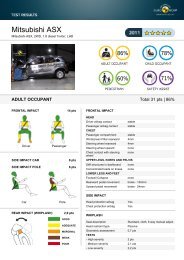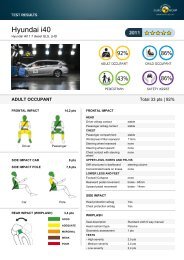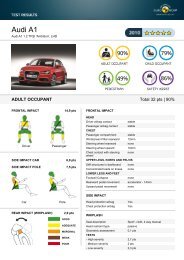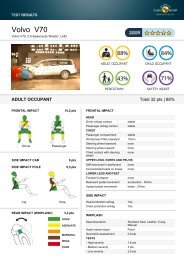Whiplash Testing Protocol - Euro NCAP
Whiplash Testing Protocol - Euro NCAP
Whiplash Testing Protocol - Euro NCAP
You also want an ePaper? Increase the reach of your titles
YUMPU automatically turns print PDFs into web optimized ePapers that Google loves.
2 DEFINITIONS<br />
For the purpose of this procedure, the following definitions shall apply:<br />
2.1 Head restraint means a device designed to limit the rearward displacement of an adult<br />
occupant‟s head in relation to the torso in order to reduce the risk of injury to the neck in the<br />
event of a rear impact.<br />
2.1.1 Integrated head restraint or fixed head restraint means a head restraint formed by the<br />
upper part of the seat back, or a head restraint that is not height adjustable and/or cannot be<br />
detached from the seat or the vehicle structure except by the use of tools or following the<br />
partial or total removal of the seat furnishings.<br />
2.1.2 Adjustable head restraint means a head restraint that is capable of being positioned to fit<br />
the anthropometry of the seated occupant. The device may permit horizontal displacement,<br />
referred to as “tilt” adjustment and/or vertical displacement, known as “height” adjustment.<br />
2.1.3 Re-active head restraint means a device designed to improve head restraint geometry<br />
during an impact. It will usually be deployed by the occupant‟s mass within the seat operating<br />
a mechanism during the crash. They also usually re-set after loading to a pre-accident<br />
condition.<br />
2.1.4 Pro-active head restraint means a device designed to automatically improve head restraint<br />
geometry prior to an impact, which utilises sensors to trigger pyrotechnics, magnetic or other<br />
device to release stored energy in order to deploy head restraint or seatback elements. Such<br />
systems require no input from the occupant to operate. They are usually not re-settable<br />
following a deployment and remain in their deployed state.<br />
2.1.5 Automatically adjusting head restraint means a head restraint that automatically adjusts its<br />
position depending on the stature of the seated occupant.<br />
2.1.6 Locking refers to an adjustable head restraint fitted with a device to prevent inadvertent<br />
downward or rearward movement from its adjusted position, i.e. when a rear seat occupant<br />
uses a front seat head restraint as a hand hold to facilitate easy entry or exit from the vehicle.<br />
A locking device may be fitted to both the horizontal and vertical adjustments of the head<br />
restraint. A locking device shall incorporate a mechanism that requires intervention to allow<br />
downward/rearward head restraint adjustment after which the mechanism shall re-engage<br />
automatically.<br />
2.2 H-Point manikin (HPM) means the device used for the determination of “H” points and<br />
actual torso angles. (SAE Standard J826, SAE Handbook, Vol 3, 1999) modified according<br />
to the Insurance Corporation of British Columbia (ICBC) Instruction Manual for the HRMD,<br />
see Appendix III.<br />
2.3 HRMD (Head Restraint Measuring Device) means a separate head-shaped device used with<br />
the H-point machine to measure the static geometry of a vehicle head restraint. It was<br />
developed under the sponsorship of the Insurance Corporation of British Columbia (ICBC) -<br />
(SAE paper 1999-01-0639). The HRMD is equipped with two probes to measure head<br />
restraint height and backset. The height probe projects horizontally, level with the top of the<br />
head, to provide a reference line for the vertical measurement to the top of the restraint. The<br />
Version 3.1<br />
June 2011<br />
2
















